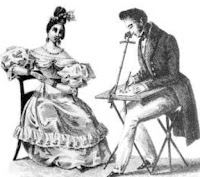by Pete Fasciano, Executive Director 02/27/2022
As noted at the outset of my quest for Ben, there was no photography. However, there was an optical imaging device, known as a ‘camera lucida’.
 |
| a ‘camera lucida’ |
The Renaissance masters had proto-cameras of a sort. They just didn’t have film. Today, it
is widely believed that the portrait masters used a lucida to project their subjects onto a canvas. This enabled them to sketch-trace the subject’s likeness quite accurately, then paint
a life-like portrait over the tracing. Et voila!
The camera lucida also could project the original tracing as a template onto a second canvas for final painting. The artist could then paint several fairly identical portraits from the same sketch. The camera lucida also enabled an impatient (or important) subject to keep the sitting brief. Quick sketch in hand, the artist was free to paint, and the subject was free to go.
There is visual evidence that Duplessis used a camera lucida in his work. (No shame in that.)
In the three extant Duplessis portraits there are consistent optical anomalies. Whether Duplessis traced Franklin’s likeness or not, he was working directly from the posed subject. A
camera lucida enhances the fidelity of Franklin’s portrayal.
The renaissance portraits that regale us to this day are very much like visual magic. And, like the magician says, “ It’s all done with mirrors.”
The camera lucida. Still in use to this day.
Want one? https://drawlucy.com
And – as always –
Thank you for listening to wfpr●fm.
And, thank you for watching.
Get this week's program guide for Franklin.TV and Franklin Public Radio (wfpr.fm) online http://franklin.tv/programguide.pdf
